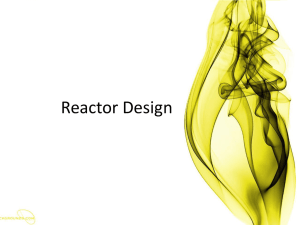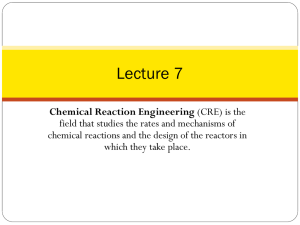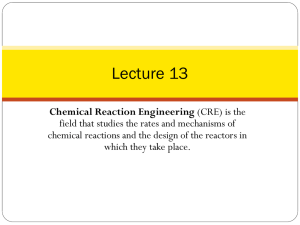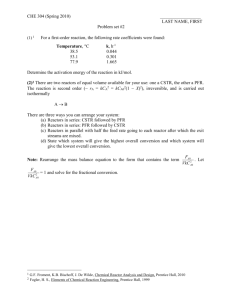ISOTHERMAL REACTIONS
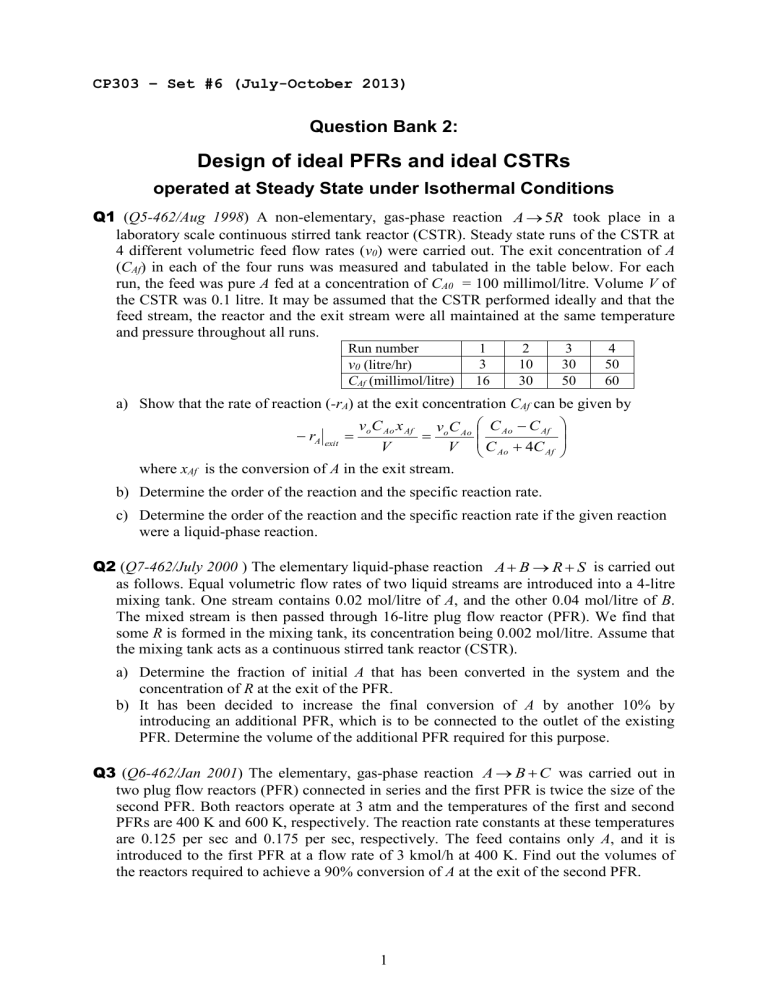
CP303 – Set #6 (July-October 2013)
Question Bank 2:
Design of ideal PFRs and ideal CSTRs
operated at Steady State under Isothermal Conditions
Q1
( Q5-462/Aug 1998 ) A non-elementary, gas-phase reaction A
5 R took place in a laboratory scale continuous stirred tank reactor (CSTR). Steady state runs of the CSTR at
4 different volumetric feed flow rates ( v
0
) were carried out. The exit concentration of A
( C
Af
) in each of the four runs was measured and tabulated in the table below. For each run, the feed was pure A fed at a concentration of C
A0
= 100 millimol/litre. Volume V of the CSTR was 0.1 litre. It may be assumed that the CSTR performed ideally and that the feed stream, the reactor and the exit stream were all maintained at the same temperature and pressure throughout all runs.
Run number 1 2 3 4 v
0
(litre/hr) 3 10 30 50
C
Af
(millimol/litre) 16 30 50 60 a) Show that the rate of reaction ( -r
A
) at the exit concentration C
Af
can be given by
r
A exit
v o
C
Ao x
Af
V
v o
C
Ao
V
C
Ao
C
Ao
C
Af
4 C
Af where x
Af
is the conversion of A in the exit stream. b) Determine the order of the reaction and the specific reaction rate. c) Determine the order of the reaction and the specific reaction rate if the given reaction were a liquid-phase reaction.
Q2
( Q7-462/July 2000 ) The elementary liquid-phase reaction A
B
R
S is carried out as follows. Equal volumetric flow rates of two liquid streams are introduced into a 4-litre mixing tank. One stream contains 0.02 mol/litre of A , and the other 0.04 mol/litre of B .
The mixed stream is then passed through 16-litre plug flow reactor (PFR). We find that some R is formed in the mixing tank, its concentration being 0.002 mol/litre. Assume that the mixing tank acts as a continuous stirred tank reactor (CSTR). a) Determine the fraction of initial A that has been converted in the system and the concentration of R at the exit of the PFR. b) It has been decided to increase the final conversion of A by another 10% by introducing an additional PFR, which is to be connected to the outlet of the existing
PFR. Determine the volume of the additional PFR required for this purpose.
Q3
( Q6-462/Jan 2001 ) The elementary, gas-phase reaction A
B
C was carried out in two plug flow reactors (PFR) connected in series and the first PFR is twice the size of the second PFR. Both reactors operate at 3 atm and the temperatures of the first and second
PFRs are 400 K and 600 K, respectively. The reaction rate constants at these temperatures are 0.125 per sec and 0.175 per sec, respectively. The feed contains only A , and it is introduced to the first PFR at a flow rate of 3 kmol/h at 400 K. Find out the volumes of the reactors required to achieve a 90% conversion of A at the exit of the second PFR.
1
Q4
Redo Q3 replacing PFRs with CSTRs.
Q5
( Q7-462/Jan 2001 ) The elementary, liquid-phase reactions,
A
k
1 R
2 R
k
3 P were carried out in a plug flow reactor (PFR) at isothermal conditions with only A entering the reactor at a concentration of C
A0
= 2 kmol/m 3 and at a volumetric flow rate of
0.1 litre/sec. If the concentration of A at the outlet is 0.3 kmol/m
3
and rate constants are k
1
= 0.003 sec
-1
, k
2
= 0.001 sec
-1
and k
3
= k
1
– k
2
, determine the following: a) Space-time of the reactor. b) Concentrations of R and S at the outlet of the reactor. c) Volume of PFR that maximizes the concentration of R at the outlet for the given conditions.
Q6
( Q5-462/Nov 2001 ) The gas-phase reaction A
2 B
C , which is first-order in A , is carried out in a continuous flow reactor under steady state conditions. The reactor is operated at 2 bar and 227 o
C. The specific reaction rate of the given reaction at 227 o
C is k
= 0.345 min
-1
. The feed stream to the reactor at 2 bar and 227 o
C contains 50 mole% of A and 50 mole% of an inert gas. The final conversion of A required is 90%. a) Determine the space–time, defined as the ratio between the volume of the reactor and the volumetric flow rate at the entrance to the reactor, for the following cases: i) The reactor is an ideal plug flow reactor (PFR). ii) The reactor is an ideal continuous stirred tank reactor (CSTR). b) From the calculations carried out in part (a), you recommend the use of a single PFR for the given reaction. Your boss however insists the use of a combination of a PFR and a CSTR in series for the same task. Explain how you would convince your boss that a single PFR is all what you need to carry out the given reaction.
Q7
( Q7-462/Nov 2001 ) Consider the following elementary, liquid-phase reactions:
A
k
P
The reactions take place in a continuous stirred tank reactor (CSTR) operated at steady state. The reactor is assumed to behave ideally. The feed stream contains C
A0
kgmol/m
3
of
A and there is no R , S or P in the feed stream. a) Starting from appropriate mass balances over the CSTR, show that the concentrations of R in the exit stream of the CSTR is given by the following expression:
C
Rf
( 1
k
4 k
)( 1
5 k
)
C
Ao where
is the space-time of the CSTR. b) Show that C
Rf
is maximized when
1 / 5 k . c) For the case of k = 1 min
-1
and C
A0
= 2 kgmol/m
3
, sketch the concentrations of A , R , S and P in the exit stream of the CSTR as functions of
.
2
Q8
( Q6-462/Nov 2002 ) Consider the following consecutive first-order liquid-phase reaction
A
R
S a) The reaction occurs in a continuous stirred tank reactor (CSTR) operated at steady state. Concentration of A in the feed is C
A0
. If there is no R or S in the feed, show that the optimum space time ( τ opt
) required to maximize the exit concentration of R is given by opt
1 / k
1 k
2 b) If the reaction occurs in a constant volume batch reactor with the initial concentration of A as C
A0
and with no R or S present in the reactor initially, show that the changing concentration of R can be given by
C
R
k k
1
C
2
Ao k
1
exp(
k
1 t )
exp(
k
2 t )
c) Also show that, in a batch reactor, the time at which the maximum concentration of the intermediate R occurs can be given as t max
ln( k
2 k
2
/ k k
1
1
)
Q9
( Q5-462/May 2003 ) Consider the liquid-phase reaction A
2 B
C , which is first order in A . The reaction is carried out in a reactor system consisting of two continuous stirred tank reactors (CSTRs) of equal volumes connected in series. The entire system is assumed to operate at a constant temperature, and the specific reaction rate k is 21 hr
1
at this temperature. Feed stream enters the first CSTR at a flow rate of 1.2 m 3 /hr.
Concentration of A in the feed stream is 2 kgmol/m
3
. The exit stream of the first CSTR is fed to the second CSTR. Concentration of A in the exit stream of the second CSTR is to be maintained at 0.05 kgmol/m 3 . The reactor system operates at steady state, and ideal behavior of CSTRs may be assumed. a) Determine the volumes of the CSTRs required, and also the concentration of A in the exit stream of the first CSTR. b) If the reactor system of two CSTRs were replaced by one single CSTR, then show that the volume of the single CSTR would be larger than the total volume of the two
CSTRs considered in the part (a). Explain why it is so with the help of the rate curve, or otherwise.
Q10
( Q7-462/May 2003 ) A plug flow reactor (PFR) is used to carry out the following elementary, liquid-phase, reversible reaction,
A k
1 k
2
B under isothermal conditions. The rate constants of the forward and backward reactions are k
1
= 0.80 min -1 and k
2
= 1.20 min -1 , respectively. The feed stream to the PFR, which is operated at steady state, contains 2.00 mol/m
3
of A and 0.50 mol/m
3
of B . Assume that the
PFR is an ideal one. a) Show that the conversion of A at the exit, x
Af
, is related to the space-time of the PFR,
τ, by x
Af
= 0.25 [1 - exp(-2 τ)] where τ is in min. Sketch the x
Af
versus τ plot. b) Determine the equilibrium conversion of A for the given reaction. And, calculate the space-time required to achieve 95% of the equilibrium conversion of A in the exit stream of the PFR?
3
Q11
( Q6-462/Feb 2005 ) a) Consider the following liquid-phase reactions taking place in a continuous stirred tank reactor (CSTR) having a space-time of 2.5 min:
A
A
P
Q
, with the rate of production of
, with the rate of production of
P
Q
given by
given by r r p
Q
= k
= k
1
2
C
C
A
2
A where C
A is the concentration of A in the CSTR. Concentration of A in the feed stream is 1 mole/litre, and there is no P or Q in the feed. Concentrations of P and Q in the exit stream are 0.4 and 0.2 mol/litre, respectively. Assuming that the CSTR is an ideal one and is operated at steady state, determine the values k
1
of and k
2
and specify their units clearly. b) If the above reactions were to be carried out in a plug flow reactor having the same space time as 2.5 min, assuming that the PFR were an ideal one operated at steadystate, determine the following: i) Concentration of A in the exit stream of the PFR. ii) Determine the concentrations of P and Q in the exit stream of the PFR.
Q12
( Q6-462/July 2000 ) The liquid-phase, elementary reactions,
A
k
3 T take place in a steady state flow reactor under isothermal conditions with only A at concentration of C
A0
kmol/m
3
as the feed. These are liquid-phase reactions. a) If the reactor were a plug flow reactor, show that the maximum concentration of R
( C
R,max
) and the space-time to achieve the maximum concentration (τ opt
) are given by
C
R , max
C
Ao
k
1
k
2
/( k
1 k
1
k
3
) k
3
k
2
/( k
1
k
2
k
3
)
and
opt
ln
( k
1 k
1
k
2 k
3
) / k
3 k
2
b) Show that if the reactor were a continuous stirred tank reactor, the corresponding expressions are given by
C
R , max
C
Ao
k
1
k
3 k
1
k
2
2 and
opt
1 k
2
( k
1
k
3
)
Assignment 2:
Workout Q4, Q6, Q8, Q11 and Q12 of Set #6
4



